Town History
Overview
The Town of Kirkwood lies on the Northern side of the Susquehanna River and extends from the Pennsylvania border to the city limits of Binghamton, NY.
Although the town was formed in 1859, its history can be traced to its earlier Native American inhabitants whose artifacts can still be found along the river's banks and flatlands.
In the late 1700's settlers began to arrive, most coming westward from New England, and settled along the river.
Among the first to settle in the area was Jonathan Fitch who arrived about 1781. He built a water-powered gristmill near the outlet of Fitch's Creek at the present 5 Mile Point. During the next few years many more arrived and began to establish farms and the industries to support an agrarian life. The river was a primary part of the journey and present day residents can relate their ancestor's accounts of floating their household furnishings down the river.
However, to support the growing community's need to import tools, materials, and foodstuffs a more reliable means of travel was imperative. And so a private road was developed from the Hudson River to the Chenango River passing through Northern Kirkwood along what is now called Old State Road. The then – Catskill Turnpike - was heavily traveled by stage, wagon, horseback and foot.
Another important road was created from "the Bend" (Great Bend, Pa) north to present day Binghamton. Running parallel to the Susquehanna River the "River Road" (now Rt. 11) passed through Kirkwood aiding in its early development.
Establishment of a Town
Prior to the Revolutionary War the colony of New York prospered in a limited area and there was no need to expand westward beyond the Catskills. Population growth after the war, however, necessitated the opening of new lands for settlement. Four new Counties were established, one being Tioga, a huge area stretching from the Delaware River to present day Chemung County. From this large Tioga, Broome County was set off in 1806.
Within Broome County was the very large town of Chenango and from this was set off the Town of Conklin in 1824. Within Conklin two communities grew and prospered, separated by the north and south banks of the Susquehanna River.
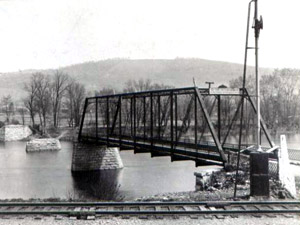 As these two communities grew, their physical separation made it increasingly difficult to carry out government's responsibilities. Most of the communications required crossing the river; and depending on the season and the water level this was accomplished by walking on the ice, fording, ferry, row boat and times an existing bridge. (Shown to the right looking from Conklin to Kirkwood)
As these two communities grew, their physical separation made it increasingly difficult to carry out government's responsibilities. Most of the communications required crossing the river; and depending on the season and the water level this was accomplished by walking on the ice, fording, ferry, row boat and times an existing bridge. (Shown to the right looking from Conklin to Kirkwood)
Even with modern day improvements the unpredictability of the Susquehanna leaves much to be desired. So in the 19th century for it to be lifeline between the 2 communities eventually would become intolerable.
In November 1859 it was decided to create 2 separate entities: Conklin on the South side of the river and Kirkwood on the north.
Actually, the separation was not as traumatic as it might seem. For example by the time of the separation each side had its own Commissioner of Highways, voting district, cemeteries, schools, churches and post offices; and for years preceding, the northern community was already known as Kirkwood. This in honor of Scottish-born civil engineer James Pugh Kirkwood who was instrumental in building the Erie Railroad through the town.
The first annual Town Meeting was held in February 1860 in the hotel kept by George Jones. The hotel, later known as the Kirkwood House, stood on the ground now occupied by the Kirkwood Fire Co. Station 1. The hotel burned in the early 1920's.
Hamlets
Under average road and weather conditions a rural family might expect to spend an hour or more to travel 3 or 4 miles to church, or Grange meeting, or to the store to trade. This took a large bite out of busy farm folk's life, and gradually small hamlets grew up to serve areas where the population was sufficient to support them.
By the turn of the 19th century there were 5 centers that had emerged; each with its own post office, church, grocery stores, and schoolhouses. Over the years their names have survived, changed, faded, or disappeared.
| Riverside
Riverside is located about a mile north of the Pennsylvania border. In its prime Riverside supported the community with its railroad flag station, creamery, blacksmith and cooper shops, and Grange Hall. (Pictured Below)
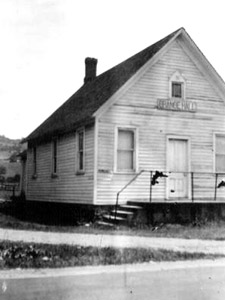
|
Kirkwood Village
Kirkwood Village had a railroad depot, hotel (Pictured Below), wagon factory, grist and sawmills, feed mill, blacksmith shop, creamery, and telegraph office.
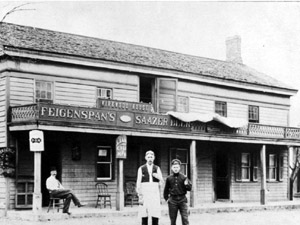
|
| Langdon
Langdon was located just north of the Village. Langdon had a railroad flag station and signal tower, and a bustling creamery. (Pictured Below)
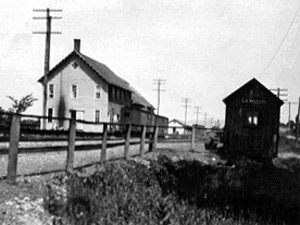
|
Kirkwood Centre
Kirkwood Centre was a settlement located midway between the Village and Binghamton (at the Five Mile Point – the distance from the Binghamton Station to the now Route 17 - "Windsor Road"). Here the 1st Grange in Broome County was established. In this area was built the Inebriate Asylum and later the vast farms that were part of the NY State Mental Hospital.
|
| Brookvale
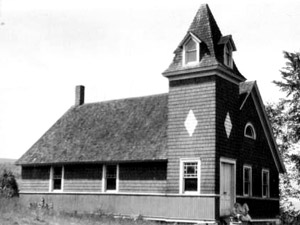
Brookvale, formerly Stanley Hollow, in the northeast part of town had its blacksmith shop and Universalist Meeting House. M.E. Church pictured above.
|
|
Development
Crucial to the town's early development was the Erie Railroad. For nearly a century the Erie provided employment in construction, maintenance, and operations and provided freight and passenger links to the rest of the country. It provided a reliable means for goods to be shipped into town and milk and other products to be exported. It was a busy time for business. Typical first-person accounts of 19th century activities were: "a boxcar load of kitchen stoves arrived at the depot"; "went to New Milford to buy a timber lot"; "went Out West (near Olean) on a cattle drove"...
In the latter half of the 20th century the railroad scaled down and the Interstate Highway system rose to prominence. Whereas, the Erie "put Kirkwood on the map", today the town benefits from modern highway transportation. Situated at the intersection of Interstate 81 and Route 17 Expressway the town once again enjoys easy access to the world.
Long before this, however, Kirkwood began to become home to the multitudes that worked in the factories and businesses of nearby Binghamton, Johnson City and Endicott. Family members left the farms in droves to work in the shoe and manufacturing industries. Today many of those industries reside in Kirkwood. The former NY State Mental facility and surrounding "Kirkwood Centre" properties have given way to a plethora of industries in manufacturing, electronics, simulation, warehousing, and building products.
In 2 centuries Kirkwood has prospered and progressed from a settlement on the river to a thriving agrarian society, and finally to a community blend of rural, residential, recreational, commercial, and light industry.
We warmly accept all visitors and residents to our town. “Our history is our future,” and Kirkwood is a town we are proud to call home.